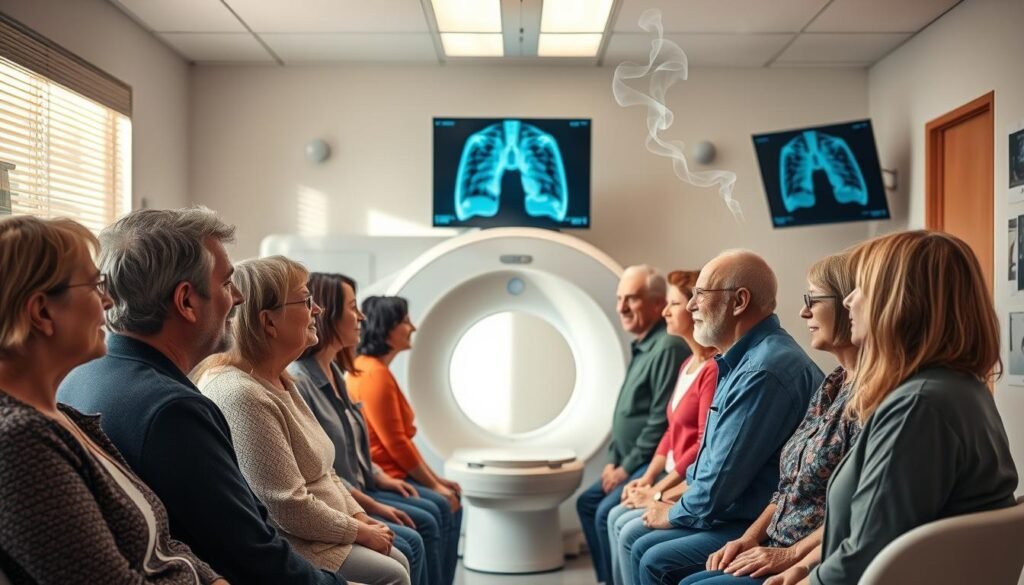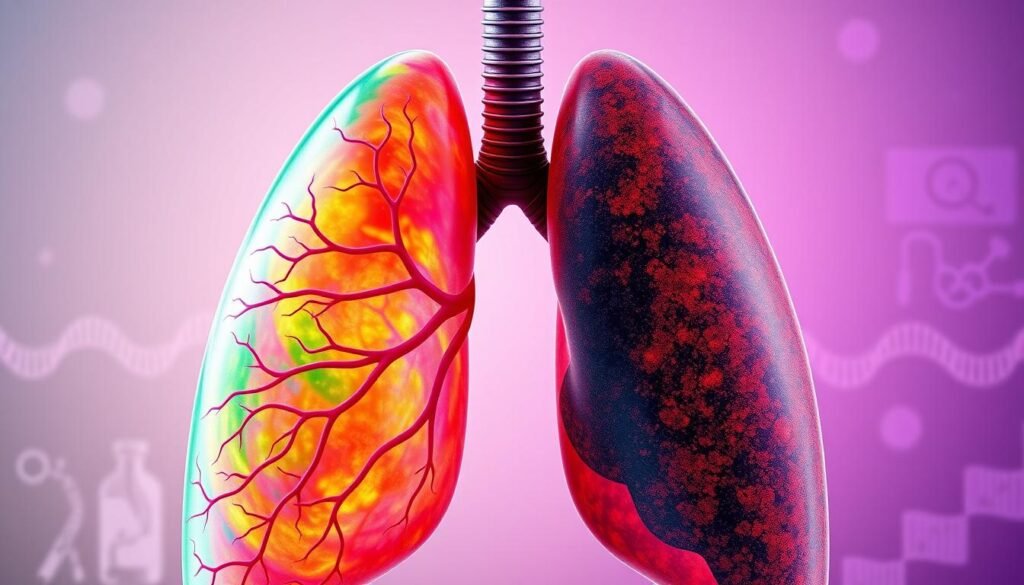Did you know 85 percent of lung cancer cases tie back to smoking? This fact highlights the link between smoking and lung cancer, especially for those who have quit. Quitting smoking does help lung health. Yet, ex-smokers have a higher lung cancer risk than those who never smoked.
Many believe their risk drops a lot once they quit. True, quitting does lower their risk compared to those still smoking. However, it is higher than for never-smokers. It’s important to know the risks that linger after quitting. Staying informed helps ex-smokers live healthier and understand quitting’s benefits for their future.
Key Takeaways
- 85% of lung cancer cases are smoking-related, showing the strong connection between tobacco use and cancer.
- Ex-smokers still face a higher lung cancer risk than those who have never smoked.
- Quitting smoking improves lung health a lot, lowering cancer risk over time.
- Knowing personal cancer risk factors is key for ex-smokers to keep healthy in the long run.
- Regular screenings are advised for people who smoked a lot to check their lung health.
The Impact of Smoking on Lung Health
Smoking is a major risk to lung health. It leads to serious diseases that affect millions worldwide. For both people who smoke now and those who’ve quit, the damage to their lungs is clear.
Understanding the Damage Caused by Smoking
Smoking harms lung tissue and lowers the lungs’ ability to work. This damage comes from toxic substances in smoke. People who smoke risk diseases like chronic obstructive pulmonary disease (COPD), lung cancer, and heart disease.
Studies show that 85% of lung cancer cases are due to smoking. Even non-smokers can suffer from secondhand smoke. It increases their chance of getting lung and other respiratory diseases.
Statistics on Smoking-Related Illnesses
Recent data show smoking’s huge effect on health. Lung cancer is the most common cause of cancer deaths. It’s responsible for about 31% of such deaths in men and 26% in women. Former smokers are most of the patients with non-small cell lung cancer, a study found.
Alarmingly, 75% of those with lung cancer die within five years of their diagnosis. This highlights how deadly smoking-related conditions are. For older men who smoke, the risk of dying from lung cancer is as high as from heart disease. This fact stresses the importance of quitting smoking.
Smoking and Lung Cancer: Ex-Smokers
Ex-smokers face a higher risk of lung cancer than those who never smoked. This risk is three times greater, even 25 years after quitting. About 85% of lung cancers are linked to smoking. It’s important for ex-smokers to know about this risk as they look after their health.
Ex-Smokers’ Elevated Risk of Lung Cancer
The risk of lung cancer decreases over time for ex-smokers. Within five years of quitting, their risk drops by 39.1%. But, their risk is still higher than that of people who never smoked. Many people with lung cancer used to smoke. This shows how past smoking affects lung health.
How Smoking Duration Affects Cancer Risk
The longer someone smokes, the higher their risk of lung cancer. Quitting before age 40 reduces most of this risk. However, people who smoked for many years still face challenges. Four in ten lung cancer cases are people who quit smoking 15 years ago. Lung cancer is the top cause of cancer deaths in the U.S. Knowing how smoking duration affects risk is crucial. For more on lung health and chronic lung disease, read about COPD and lung cancer here.
The Benefits of Quitting Smoking
Quitting smoking gives many health benefits. One key quit smoking benefit is a big drop in lung cancer risk. People who quit can lower their risk by 39.1% in five years. This risk keeps going down over time, making quitting key for better health.
Reduced Lung Cancer Risk After Cessation
Long-term studies show quitting has lasting benefits. A key fact is quitting before 40 cuts the risk of dying from smoking-related diseases by 90%. This includes lower risks of many cancers, like those of the stomach and liver. It can add up to ten years to your life compared to continuing smokers.
For those with lung cancer, quitting can also extend your life.
Immediate and Long-term Health Benefits
Quitting smoking also brings immediate health perks. Ex-smokers see better lung function and lower blood carbon monoxide levels within hours. Key short-term benefits include:
- Improved taste and smell
- Fresh breath, hair, and clothes
- Reduced yellowing of teeth and nails
- Less breathlessness during physical activity
In the long run, quitting lowers the chance of getting chronic obstructive pulmonary disease (COPD), boosts circulation, and cuts cancer risk. Check out this source for more on lung cancer detection and screening.
Understanding Lung Cancer Risk Factors
Lung cancer is not just about smoking. Age, race, and family history also play a role. Knowing these factors helps us understand our risk.
Other Contributing Factors Beyond Smoking
Smoking is behind most lung cancer deaths in the US. But there are other dangers too. Things like radon and asbestos can also be harmful. Being around these can increase your lung cancer risk.
Chronic lung diseases can make things worse. They change how your lungs work, making cancer more likely.
- Radon exposure, a leading cause of lung cancer, particularly for smokers
- Asbestos increases the risk of lung cancer significantly
- Air pollution contributes to about 1% to 2% of lung cancer deaths
- Radiation therapy to the chest for prior cancers raises lung cancer risk
The Role of Family History in Lung Cancer Incidence
Having a family member with lung cancer raises your own risk. This shows that lung cancer can run in families. It’s about the genes we share.
“Brothers, sisters, and children of lung cancer patients may have a slightly higher risk of developing the disease themselves.”
Researchers are looking into how diet might affect lung cancer risk. They’re also studying more about how smoking ties in. Being aware of these risks is key to managing them.
Secondhand Smoke Exposure
Secondhand smoke is very bad for health, and it can make non-smokers get cancer. It’s dangerous for people of all ages. This shows why we need to stay away from tobacco smoke from others. Studies prove that if you’re around secondhand smoke when you’re young, your lung cancer risk goes up a lot.
How Secondhand Smoke Increases Cancer Risk
Research shows a strong link between secondhand smoke and lung cancer. If you’re around secondhand smoke from birth to age 25, your lung cancer risk is higher. The risk is lower if you’re first exposed after age 25. The findings tell us that being around secondhand smoke early in life really increases your chance of getting cancer.
Protecting Loved Ones from Secondhand Smoke
To keep your family safe, especially kids and those with health problems, you must act against secondhand smoke. Choosing places where smoking isn’t allowed can greatly lower lung cancer risk from secondhand smoke. Knowing about the dangers of smoking helps too. You can make your home healthier by asking smokers not to smoke inside. This makes your home free from tobacco smoke.
| Age of Exposure | Adjusted Odds Ratio for Lung Cancer | Population Characteristics |
|---|---|---|
| Birth to Age 25 | 1.30 (1.08-1.57) | Participants included non-smokers, ex-smokers, and current smokers |
| After Age 25 | 0.66 (0.21-1.57) | Median age of population was 62 years |
| Nonsmokers Ever Exposed | 1.29 (0.82-2.02) | 21% were non-smokers |
| Current and Ex-Smokers Combined | 1.28 (1.04-1.58) | 50% were ex-smokers |
Cancer Screening Recommendations for Former Smokers
It’s key for former smokers to get regular lung cancer checks. Especially those who smoked a lot in the past. Early finding of lung cancer can greatly boost survival chances by catching the disease early. The American Lung Association says yearly scans are vital. They recommend low-dose computed tomography (CT) scans for this.
Importance of Regular Lung Cancer Screening
Screening can spot lung cancer early, when it’s easier to treat. In 2020, about 228,820 people in the U.S. were told they had lung cancer. This led to 135,720 passing away. Almost 90% of these cases were due to smoking. That’s why screening is so important for catching it early.
Recommended Age and Frequency for Screenings
The newest advice says people 50 to 80 with at least a 20 pack-year smoking history should get checked every year. This is true even if they’ve stopped smoking or haven’t smoked in the last 15 years. The American Cancer Society’s updated rules mean more people can get screened. Now, about 5 million more people can get checked for lung cancer each year.
| Age Range | Screening Frequency | Eligibility Criteria |
|---|---|---|
| 50-80 years | Annually | 20 pack-year smoking history and currently smoking or quit within the past 15 years |

Nicotine Addiction and Its Effects on Smoking Cessation
Nicotine addiction is a huge hurdle for those trying to quit smoking. The journey to stop smoking is hard due to cravings and withdrawal symptoms. It’s vital for anyone wanting to beat nicotine addiction and quit smoking to understand these challenges.
Understanding Nicotine Withdrawal Symptoms
Stopping smoking leads to withdrawal symptoms. People often feel:
- Anxiety and irritability
- Intense cravings for nicotine
- Difficulty concentrating
- Increased appetite and potential weight gain
- Sleep disturbances
These symptoms can make quitting smoking tough. Knowing about them helps prepare individuals for the battle ahead.
Strategies for Overcoming Nicotine Addiction
There are several strategies that help fight nicotine addiction. These methods increase the chances of quitting smoking successfully:
- Behavioral therapy: This involves working with a therapist to change habits and thoughts related to smoking.
- Support group participation: Being part of a group offers support and encourages quitting.
- Nicotine replacement therapies: Products like patches, gum, or lozenges help reduce symptoms.
- Prescription medications: Some medicines can help ease cravings and symptoms, aiding in quitting efforts.
Lifestyle Changes Post-Cessation
Starting a recovery journey after quitting smoking means making big lifestyle changes. These changes are key to better lung health and overall well-being. Eating right is central to recovery, helping the body heal.
Adopting a Healthier Diet for Lung Health
Eating foods rich in antioxidants helps fix smoking-caused damage. Include fruits, vegetables, nuts, and whole grains. These foods fight inflammation.
- Berries: High in antioxidants
- Leafy greens: Rich in vitamins and minerals
- Beans: Excellent source of protein and fiber
- Fatty fish: Contains omega-3 fatty acids
- Citrus fruits: Boost vitamin C intake
The Role of Exercise in Recovery
Regular exercise is crucial for your lungs after you quit smoking. It builds lung strength and betters breathing. Try these activities:
- Aerobic activities, such as walking or cycling
- Strength training for overall physical fitness
- Breathing exercises to improve lung function
Exercise aids both body and mind. It boosts your mood and keeps you motivated on your recovery path.

| Time After Quitting | Health Improvements |
|---|---|
| Minutes | Heart rate drops |
| 1 to 12 months | Coughing and shortness of breath decrease |
| 1 to 2 years | Risk of heart attack declines sharply |
| 5 to 10 years | Added risk of mouth, throat, and voice box cancers drops by half |
| 10 to 15 years | Added risk of lung cancer drops by half |
Embracing lifestyle changes and sticking to a lung health diet deeply impacts recovery. It vastly improves health and well-being.
Support Groups and Resources for Ex-Smokers
Quitting smoking is tough, but support groups and resources can really help. These groups bring together people going through the same thing. They offer support and share tips on how to quit successfully.
How Support Groups Enhance Quitting Success
Being part of a support network gives ex-smokers a boost. About 70% of smokers who join these groups have a better shot at quitting. Groups like Nicotine Anonymous and local communities provide a space where everyone understands each other. This makes people feel strong and supported.
Available Resources for Smoking Cessation
There are many resources out there to help people stop smoking. Healthcare providers and organizations like the National Cancer Institute give out important information. Phone services work just as well as meeting face-to-face. They provide help when you need it, even outside normal hours.
Every state has its own program, which you can reach by calling 1-800-QUIT-NOW. The National Cancer Institute’s Quitline and the American Cancer Society’s Quitline are great too. Websites like Smokefree.gov give personalized tips and tools to help you through the quitting process.
Research Highlights on Lung Cancer
Recent studies have shown a clear link between smoking and lung cancer. About 85% of lung cancer cases are due to smoking. This fact is a major concern worldwide. Thanks to new early detection methods, we now see better survival rates. For example, the five-year survival rate rose from 17.2% to 21.7% recently.
Recent Studies Linking Smoking and Lung Cancer
A key study looked at 16,832 patients with a lung condition called COPD who smoked less. It found that people who kept smoking had the highest lung cancer rates. People who smoked less or quit had a much lower risk. Quitting smoking especially showed a big decrease in lung cancer risk.
These findings make it clear: smoking less or quitting helps lower lung cancer rates. This is a big plus for your health. To learn more, check out the detailed lung cancer research done on this.
Trends in Lung Cancer Survival Rates
New screening methods have really helped people survive lung cancer longer. By studying gene mutations, scientists have learned a lot. They found something interesting about former smokers. Their lungs had more healthy cells than those who still smoked. This could protect them from getting cancer.
This discovery shows how stopping smoking might help prevent lung cancer. It’s an important reason to keep researching and improving how we treat lung cancer. This can help more patients survive this disease.

Other Respiratory Diseases Associated with Smoking
Smoking does more than cause lung cancer. It makes ex-smokers prone to other respiratory diseases. By quitting, they can improve their lung health. But, they often face chronic issues needing ongoing care. It’s vital for them to know these risks and keep their lungs healthy.
Common Respiratory Diseases Among Ex-Smokers
Ex-smokers frequently get diseases like COPD, asthma, and various interstitial lung diseases (ILDs). These conditions are linked to smoking:
- COPD is a global issue mainly caused by tobacco.
- Smoking history is tied to ILDs such as respiratory bronchiolitis-associated ILD and desquamative interstitial pneumonia.
- Smoking can also lead to idiopathic pulmonary fibrosis and rheumatoid arthritis-associated ILD.
Studies show smoking increases osteopontin levels in those with smoking-related ILDs. Cigarette nicotine pulls in inflammatory cells, hurting the lungs long-term.
Preventative Measures to Maintain Lung Health
For ex-smokers, keeping lungs healthy is key. They can lower disease risk by:
- Having regular check-ups to spot lung issues early.
- Eating foods rich in antioxidants for better lung health.
- Doing regular exercise to improve respiratory health and well-being.
- Staying away from pollutants to avoid more lung harm.
Ex-smokers must actively look after their lungs. Knowing the risks from past smoking helps make better health choices. For extra info on how smoking affects breathing, check this resource.
Conclusion
It’s vital to know the risks that ex-smokers face with lung cancer and other diseases from smoking. Quitting smoking is a big step towards health, yet many struggle with their past. But, over 38 million Americans have quit smoking. This shows that positive change is achievable and good for health.
Quitting smoking has huge benefits. People who stop smoking live longer than those who keep smoking. Research shows that quitting by age 50 cuts the risk of dying in 15 years by half. And those who quit by 40 greatly reduce their lung cancer risk, avoiding up to 91% of the excess risk.
Today, we have better cancer screening methods and more help to quit smoking. These resources help ex-smokers improve their health and live better lives. Making the commitment to quit, with the right support, can lower risk and lead to a healthier future for everyone.